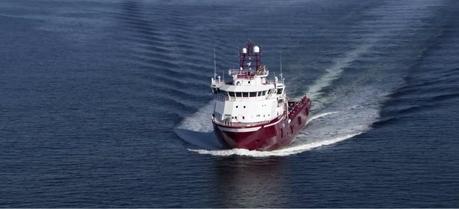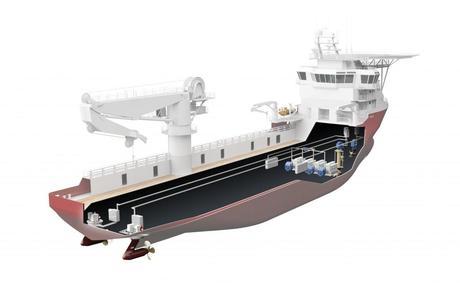 Dina Star, 93 meter long, 5000 tonnes, a multi-purpose offshore supply and construction vessel, was a test site for ABB Onboard DC Grid technology.
Dina Star, 93 meter long, 5000 tonnes, a multi-purpose offshore supply and construction vessel, was a test site for ABB Onboard DC Grid technology.ABB, a multinational corporation operating mainly in the power and automation technology areas, recently released third-party verification that its Onboard DC Grid helps ships save fuel, decrease noise and cut their environmental impact.
The measurements and tests, conducted by Pon Power in collaboration with ABB on Myklebusthaug Offshore’s platform supply vessel “Dina Star,” identified reduction of specific fuel oil consumption of up to 27%. These are the first documented results from a vessel outfitted with ABB’s Onboard DC Grid, which allows engines to run at variable speeds for top fuel efficiency at each load level.
SEE ALSO: Shape-Changing Wings to Help Aircraft Save Fuel

ABB’s Onboard DC grid system render. (Credit: ABB). Click to enlarge.
The tests also measured fuel consumption in dynamic positioning operations during challenging weather conditions, identifying fuel savings of 14%. Dynamic positioning operations, where computers automatically maintain a vessel’s position and heading, account for a considerable portion of a typical offshore vessel’s operational profile.
“Our Onboard DC Grid is a significant step forward for electric propulsion. We are pleased that the concept delivered results that exceed our expectations,” said Veli-Matti Reinikkala, head of ABB’s Process Automation division. “Onboard DC Grid is a competitive advantage to ship owners operating a wide range of ship types from offshore vessels to ferries and yachts seeking to increase fuel efficiency and reduce emissions.”
In addition to fuel consumption, Pon Power and ABB measured Onboard DC Grid’s effect on engine room noise levels. Tests showed 30% noise reduction, contributing to improved working conditions aboard the vessel.
The new system merges the various DC links around the vessel and distributes power through a single 1,000 V DC circuit, thereby eliminating the need for main AC switchboards, distributed rectifiers and converter transformers. All electric power generated is fed either directly or via a rectifier into a common DC bus that distributes the electrical energyto the onboard consumers. Each main consumer is then fed by a separate inverter unit.
When an AC distribution network is still needed, for example with a 230 V hotel load, it is fed using island converters, developed by ABB to feed power to this circuits. Additional converters for energy storage in the form of batteries or supercapacitors can be added to the DC grid. These devices can further improve the energy efficiency of the ship.
Onboard DC Grid system allows engines to be operated at different speeds. As a result, the fuel consumption and emissions are reduced significantly in comparison with traditional propulsion systems. The system also allows for improved dynamic response of the engines.

